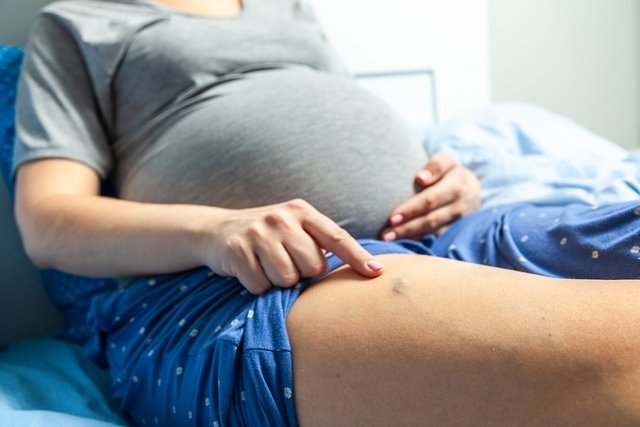Varicose veins during pregnancy arise due to an increase in the volume of blood circulating in the body, increased weight, hormonal changes and pressure from the uterus on the pelvic blood vessels, being more common to appear in the 3rd trimester, causing symptoms such as a feeling of heaviness in the legs, pain or itching at the site.
Varicose veins are dilated and tortuous bluish or purplish veins that can be easily seen under the skin, and that during pregnancy can appear on the legs, ankles, groin, perineum or vulva, for example.
Treatment of varicose veins during pregnancy is not always necessary, as they tend to disappear after childbirth. However, it is important to consult an obstetrician who may recommend the use of compression stockings to facilitate the return of blood from the legs to the heart, in order to prevent the appearance of varicose veins or alleviate symptoms.

Symptoms of varicose veins in pregnancy
The main symptoms of varicose veins in pregnancy are:
- Feeling of heaviness in the legs;
- Itching at the site of varicose veins;
- Leg cramps, especially at night;
- Pain in the legs, ankles or groin;
- Swelling in the legs or ankles, especially at the end of the day.
Furthermore, when varicose veins appear in the vulva, perineum or groin, called pelvic varicose veins, symptoms such as a feeling of heaviness in the intimate area and pain during and/or after intimate contact may occur. Another type of varicose veins that can appear are hemorrhoids, which are also common during pregnancy. Know how to identify the symptoms of hemorrhoids during pregnancy.
It is important to always have prenatal care with an obstetrician, in order to identify varicose veins and recommend the best treatment, if necessary.
Furthermore, if the pregnant woman presents symptoms such as intense swelling, redness or a sensation of heat in the affected vein, an angiologist should be consulted, as this could be a sign of phlebitis. Understand what phlebitis is, symptoms and treatment.
How to confirm the diagnosis
The diagnosis of varicose veins during pregnancy is made by the obstetrician, during prenatal consultations, through the assessment of symptoms and physical examination, through observation of the characteristics of the blood vessels.
Make an appointment with an obstetrician in the nearest region:
Taking care of your health has never been easier!
If symptoms are intense, the doctor may request an ultrasound examination with Doppler to assess the blood flow in the blood vessel or the presence of clots. Find out how the Doppler ultrasound exam is performed.
Possible causes
Varicose veins in pregnancy are caused by a combination of factors, which are:
- Increased levels of progesterone in the body, which makes blood vessels more dilated;
- Increase in the volume of circulating blood, by 40 to 50%;
- Weight of the uterus that can compress the veins and arteries in the pelvic region, making it difficult for blood to return from the legs to the heart;
- Weight gain during pregnancy.
Furthermore, other factors can increase the risk of developing varicose veins during pregnancy, such as obesity, a family history of varicose veins, or an inadequate diet, with excessive salt consumption or low water intake.
How the treatment is carried out
The treatment of varicose veins during pregnancy must be guided by the obstetrician, and in most cases it is not necessary, as varicose veins tend to disappear after 3 or 4 months after the baby is born.
However, your doctor may advise you to exercise regularly to improve blood circulation and elevate your legs above heart level whenever possible.
In some cases, the doctor may also recommend the use of compression stockings to prevent the appearance of varicose veins and aid blood circulation.
If varicose veins do not disappear after childbirth, your doctor may recommend laser treatment or surgery to remove the varicose veins. Check out the treatment options for varicose veins.
Can people with varicose veins have a natural birth?
Pregnant women with varicose veins can have a normal birth, as they do not interfere with childbirth, since varicose veins, even vulvar varicose veins, have low blood flow.
However, very large varicose veins or the presence of inflammation in the veins must be evaluated by the doctor before delivery.
How to avoid varicose veins during pregnancy
Varicose veins during pregnancy appear mainly due to hormonal changes, however it is possible to prevent their appearance by taking some precautions, such as:
- Do not stand for a long time;
- Avoid crossing your legs when sitting;
- Elevate your legs while sleeping;
- Massage your feet and legs at the end of the day;
- Wear elastic socks during the day.
Furthermore, it is important for women to exercise regularly under the guidance of a physical education professional to increase the resistance of their veins and prevent them from dilating.
Bibliography
- ISMAIL, L.; et al. A systematic review and meta-analysis of the risk for development of varicose veins in women with a history of pregnancy. J Vasc Surg Venous Lymphat Disord. 4. 4; 518-524.e1, 2016
- SMYTH, R. M.; et al. Interventions for varicose veins and leg oedema in pregnancy. Cochrane Database Syst Rev. 2015. 10; CD001066, 2015
- GARG, AM; et al. Dermatologic and Cosmetic Procedures in Pregnancy. J Cutan Aesthet Surg. 15. 2; 108-117, 2022
- DeCARLO, C.; et al. Pregnancy conditions and complications associated with the development of varicose veins. J Vasc Surg Venous Lymphat Disord. 10. 4; 872-878.e68, 2022

Sign up for our newsletter and stay up to date with exclusive news
that can transform your routine!
Warning: Undefined array key "title" in /home/storelat/public_html/wp-content/plugins/link-whisper-premium/templates/frontend/related-posts.php on line 12
Warning: Undefined array key "title_tag" in /home/storelat/public_html/wp-content/plugins/link-whisper-premium/templates/frontend/related-posts.php on line 13




